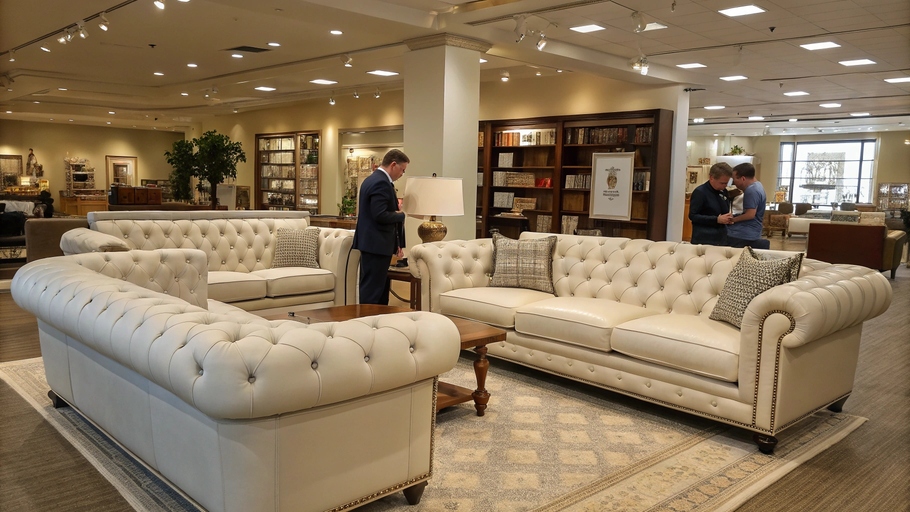
As independent retailers, it’s tempting to prioritize low prices when sourcing products. However, focusing solely on price often leads to hidden costs—both for your business and for your customers. In the furniture industry, particularly for sofas, quality should always come first.
The real cost of prioritizing price is often seen in poor durability, customer dissatisfaction, and brand damage.
Let’s explore why quality matters more than price and why independent retailers should focus on offering high-quality products for long-term success.
The Real Cost of Cheap Products
When customers ask for cheaper options, retailers often feel the pressure to comply, sometimes by sacrificing product quality1. While reducing costs may seem like a way to increase profit margins in the short term, it often leads to significant long-term losses2.
The true cost of cutting corners on quality is seen in the product’s lifespan, customer satisfaction3, and the retailer's reputation.

Short-Term Savings vs. Long-Term Losses
Initially, cheap products may seem like a good deal. However, over time, they fail to meet expectations. For instance, low-quality upholstered furniture might save you money upfront, but it will wear out faster, resulting in higher return rates and customer complaints. These issues will eventually damage your business.
When customers find that products are not as durable as they thought, they are more likely to leave negative reviews, return products, and avoid purchasing from your store again. This cycle can harm your brand and reduce profitability in the long run.
The Hidden Costs for Independent Retailers
Selling cheaper products might attract customers initially, but it often costs more to retain them. The major hidden cost is dissatisfaction. Once a customer is unhappy with a product, they may return it, leave a negative review, and potentially choose competitors in the future.
Competing on price alone also puts retailers at a disadvantage by lowering profit margins, forcing you to sell higher volumes to maintain profitability. However, with quality products, retailers can build long-term customer loyalty and benefit from repeat business.
The Importance of Product Quality
Quality is more than just durability. It’s about providing customers with products that exceed their expectations, fostering trust, and encouraging long-term relationships. Independent retailers who focus on quality over price differentiate themselves from competitors who focus only on low-cost options.
By focusing on quality, you create value for your customers that lasts longer and encourages them to come back for more.

Why Quality Over Price is the Right Choice
Customers who value quality are more willing to invest in higher-priced products if they believe the product will last longer and perform better. Offering high-quality furniture4, such as the durable upholstery products from Starborn Furniture, sets you apart from mass-market retailers that focus only on price.
Retailers who emphasize the craftsmanship and durability5 of their products can educate customers about the long-term value, helping them understand why a higher price point often reflects better quality and longevity.
Common Ways Raw Materials Are Cut to Save Costs
In the Chinese furniture manufacturing industry, cost-saving measures6 are often employed at the expense of material quality. Rather than simply substituting materials, some suppliers reduce the grade or thickness of raw materials in order to lower costs, leading to inferior products.

Wood Frame Issues
For sofas, the frame is one of the most critical components for durability. However, in an effort to cut costs, many manufacturers use thinner plywood7 or lower-grade materials8. For example, plywood might be reduced from a standard 2 cm thickness to just 1.8 cm or even 1.5 cm. This reduction in thickness weakens the frame, making it less stable and more prone to breaking over time.
Even if there is no problem with the design, using lower-grade or thinner plywood7 for crucial structural areas compromises the sofa’s strength.
| Material Type | Standard Thickness | Cost-Cutting Action | Resulting Problem |
|---|---|---|---|
| Plywood | 2 cm | Reduced to 1.5 cm | Weakened frame strength |
| Hardwood | Solid wood | Lower-grade softwood | Increased risk of breakage |
| Frame Joints | High-quality wood | Small pieces, cheap wood | Loosening and instability |
Foam Quality and Density Issues
Foam is another area where cost-saving measures are often applied. Suppliers may add fillers, such as stone powder, to increase the foam’s density at a lower cost. While this might seem effective in meeting the required density specifications, it compromises the foam’s elasticity and durability9.
In sofas with spring systems, the foam is often less noticeable. However, this cost-saving practice can lead to sagging cushions and uncomfortable seating, resulting in poor customer experiences and increased returns.
| Foam Type | Standard Density | Cost-Cutting Action | Resulting Problem |
|---|---|---|---|
| High-Density Foam | 30-40 kg/m³ | Added fillers (stone powder) | Reduced durability, discomfort |
| High-Density Foam | Elastic foam | Low-grade foam with fillers | Loss of elasticity, rapid degradation |
Fabric Compromise
The weight and durability of fabric are often reduced to save costs. Lighter fabrics may be used that look similar to the original design but are far less durable. These lighter fabrics wear out faster, pill, and tear more easily under regular use, affecting the sofa’s long-term appearance and functionality.
| Fabric Type | Standard Weight | Cost-Cutting Action | Resulting Problem |
|---|---|---|---|
| Durable Fabrics | 300-500 g/m² | Reduced to 200 g/m² | Increased wear, pilling, and tearing |
| Upholstery Fabric | Heavy linen | Thinner polyester blends | Poor abrasion resistance |
The Hidden Costs of Lower-Quality Products
The effects of cutting corners in product quality go beyond the physical issues with the furniture itself. For retailers, the long-term costs can significantly outweigh any initial savings.

Customer Dissatisfaction10
Cheap products often lead to returns, complaints, and poor reviews. Negative feedback can spread quickly, especially in the age of online reviews, leading to a damaged reputation and reduced customer trust.
Brand Erosion11
Independent retailers rely heavily on their brand reputation. Lower-quality products undermine trust in your brand, which can lead to a loss of customers. Once customer trust is lost, it is difficult to regain.
Long-Term Costs12
While saving on production costs might seem like a good idea in the short term, the long-term effects of poor-quality products—such as lost customers, increased return rates, and negative reviews—can seriously harm your business.
The Power of Investing in Quality
Investing in quality materials and craftsmanship13 is an investment in your brand, your reputation, and your customers. Independent retailers who choose high-quality products over cheap alternatives stand to gain much more in terms of customer loyalty and long-term profitability.

Why Higher Quality Products Are Worth the Investment
Retailers who focus on quality can command higher prices and provide products that stand the test of time. By educating customers about the value of higher-quality products, you help them understand that they are not only buying a product but making a smart, long-term investment.
At Starborn Furniture, we emphasize using only the best materials, including thicker plywood, high-density foam without fillers, and durable fabrics. Our products are designed to last, providing your customers with quality they can trust.
Educating Your Customers
It’s essential for independent retailers to educate customers on the long-term benefits of investing in quality14. While customers may initially hesitate at higher prices, explaining how better materials and craftsmanship result in better value over time will help them make more informed decisions.
Conclusion
While price is important, focusing solely on price often leads to long-term costs that far exceed any initial savings. Independent retailers can thrive by offering high-quality, durable products that provide long-term value to their customers. By educating your customers on the importance of quality, you can build lasting relationships and grow your business.
At Starborn Furniture, we are committed to providing top-quality products that offer unmatched durability, comfort, and style. When you choose quality, you choose success.
-
Understanding the importance of product quality can help retailers make informed decisions that enhance customer satisfaction and loyalty. ↩
-
This resource will provide insights into the hidden costs of cheap products, helping retailers avoid costly mistakes. ↩
-
Exploring this topic reveals how satisfied customers can lead to repeat business and higher profits, crucial for long-term success. ↩
-
Investing in high-quality furniture ensures durability and long-term value, making it a smart choice for any home. ↩
-
Exploring craftsmanship and durability can reveal how these factors contribute to product longevity and customer satisfaction. ↩
-
Understanding cost-saving measures can help consumers make informed choices about furniture quality and durability. ↩
-
Learning about the effects of thinner plywood can guide buyers in selecting more durable and reliable furniture options. ↩ ↩
-
Exploring the impact of lower-grade materials can reveal the trade-offs between cost and quality in furniture manufacturing. ↩
-
Understanding how fillers impact foam can help you make informed choices for better quality products. ↩
-
Understanding customer dissatisfaction can help businesses improve their products and services, ultimately enhancing customer loyalty and trust. ↩
-
Exploring brand erosion can provide insights into maintaining a strong brand reputation and customer trust, crucial for long-term success. ↩
-
Learning about long-term costs can guide retailers in making informed decisions about product quality, impacting their overall profitability. ↩
-
Explore this link to understand how quality materials enhance product value and customer satisfaction, leading to long-term success. ↩
-
Learn about the lasting advantages of quality investments for both retailers and customers, ensuring informed purchasing decisions. ↩

